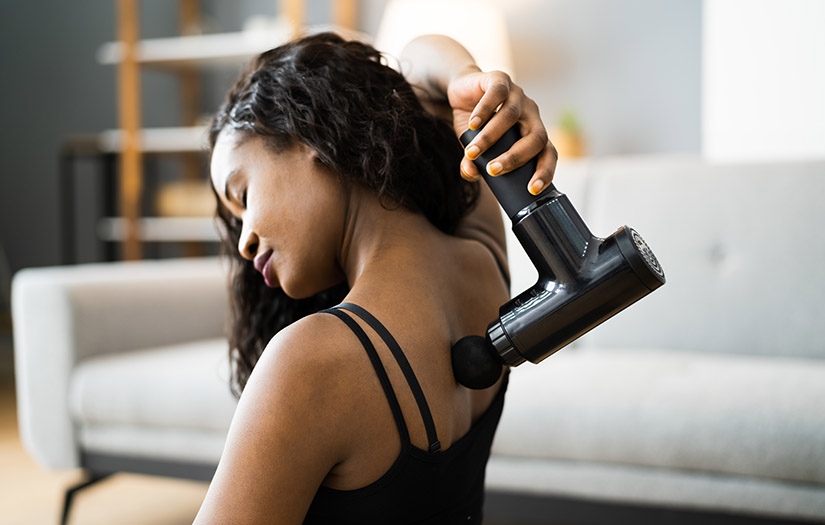We’re introducing a new series on the “NASM-CPT Podcast” we like to call, “Do They Really Work?”
Host, and NASM Master Instructor, Rick Richey will sift through his mail bag to give clarity to your questions. This episode focuses on massage guns, which have gained quite a bit of popularity. Rick explains the purpose of this product, what scientific research has shown, and his personal thoughts and experiences with massage guns during his fitness career.
Rick Richey is a NASM-CPT, CES, PES, and Master Trainer.
Transcript
00:03
You're listening to the NASM CPT podcast with Rick Richey, the official podcast of the National Academy of Sports Medicine.
Rick Richey
00:15
Hey, y'all, and welcome to the NASM CPT podcast. My name is Rick Richey. And today we're picking up on another episode of “Do they really work?”
And this episode of “Do they really work?”, we're going to be talking about vibrating foam rollers. And I love them. I have all sorts of them and brands of them. My kids love them, they love to turn them on and just watch them move around the floor on their own as if they as if the foam roller needs to be exorcised of a demon that's just making a move everywhere.
They just—it's fun. But the question is, do they work? So, we must now go to the research to identify whether or not these vibrating foam rollers actually do anything. So, let's first go to a study done in 2019 by Romero, and all the colleagues with multiple hyphenated names, they had 36 healthy individuals that were volunteers that signed up for this study. And what they did is they did the best they could to make them soar.
So, they put them through 10 sets of 10 repetitions of something called K box squats. And if you're not familiar with a K box, it is an inertia flywheel. So, what they do is you stand on this platform, and there is a flywheel there, and you're strapped to something around your waist, and you squat and give you resistance going up. And then that wheel pulls and your lower back down and it can resist you on the way down.
So, what they did is they set it up to do more resistance on the eccentric phase. For the absolute purpose of inducing Dom's delayed onset muscle soreness to make you sore, the second-day soreness is what I like to call it because two days later, it seems to be worse than the day after. Ouch.
So, 48 hours later, the second day. So, they measured the soreness, they said, “Alright, let's do what they called a visual analog scale where they took several different categories just to see how sore they were.” And one of those was passive, just like are you passively sore without doing anything, no squatting, just lying there? Do you feel your legs being sore?
The other thing was a pressure pain threshold. So, they put pressure on the thighs. And if you felt it, then you certainly know that you're sorted. By the way, anybody that was not sore was excluded from the study. So, they were only doing this to check to add in that component. So, oxygen saturation, they were checking countermovement jump.
So that is an interesting one because there is a performance measure that's included in there. And then they did hip in the range of motion testing, after eliciting this muscle damage. So, one group was on a regular foam roller. The other group was on a vibrating foam roller, it was hyper ice, vibrating foam roller at 18 hertz.
So here are the five things: the first important finding is that the vibration foam roller group, the people that were on the vibrating foam rollers had greater short-term benefits when it came to pain perception. And when it came to passive hip extension range of motion.
Rick Richey
03:48
And that's after they induced the eccentric muscle damage. So, two things are their pain perception and the acute level and then passive hip extension range of motion. What was also interesting is that both the vibration and the nonvibrating foam roller protocols achieved similar short-term results and pressure pain threshold, the countermovement jump oxygen saturation and active hip extension range of motion, and knee flexion range of motion. So aside from the pain perception, which let's be honest, if you're sore, then that's going to be valuable to you. And the passive hip range of motion. There was no significant difference between the regular foam roller that did not vibrate and the vibrating foam roller.
So, there were a couple of things that were better but in general, everything was relatively similar. So let's go to the next study and these are isolated studies and then we're going to get into a systematic review and meta-analysis so stay with me, de Benito at all 2019 2015 for individuals that volunteered randomized and vibration, foam roller, and the control, so there's a vibration roller, a regular foam roller and a control group that then use the foam rolling, they did assessments like sit and reach test, they did a y balance test, a post-treatment perceived knee and ankle stability, then they did a warm-up.
And they did the warm-up followed by lunges until the additional fatigue. And then they did foam roller. And they did a vibrating foam roller. And the condition showed that there was greater ankle stability and range of motion greater posterior medial and posterior-lateral reach distance on the wide test, and better knee and ankle stability when compared to the control group or the nonfoam roller group. However, there were no differences that we're seeing between the regular foam roller and the vibrating foam roller under these conditions. Interesting.
The article, entitled The Effect of Vibration Foam Rolling On a Range of Motion and Healthy Adults a Systematic Review and Meta-Analysis, was published in the Journal of Exercise Rehabilitation. And they found eight studies, six of which were randomized controlled trials because the other two were not RCTs, then that includes them into the systematic review.
If they were all randomized controlled trials, then it would simply be a meta-analysis. With that said 230 healthy people ended up volunteer volunteering during the eight studies that are there. So, they did something called a Petro Scale. And the PED in all caps are little.
So that scale. It's a scale that allows researchers to evaluate the research. And they found that on average, that this research was considered fair, the score selection of all of these eight studies, when put together was considered to be fair, so about a 4.5 out of a possible 10. That would have made them just incredible study.
So, with that being said, the vibrating foam rollers were more effective in improving range of motion, than the regular foam rollers in the hip and the knee joints. Alright, they found that it was of benefit to increase range of motion at hip and knee for healthy populations. So, with that being said, if there's a healthy population, and especially in hip and knee RLM, then they found in general as a general rule that the vibration foam roller was better.
Rick Richey
07:53
But it wasn't that much better. When you look at the research and you look at the content that was there it was significant. There was some significance there and there were some ranges of motion that significance was not found.
So, several additional studies also included dynamic stretching into the warm-up. And they found that to be beneficial and it can be additionally helpful with either a foam roller or a vibrating foam roller. So, what they did, they did dynamic flexibility, dynamic stretching, and then they did dynamic stretching with the foam roller and dynamic stretching with the vibrating foam roller. The research studies there were two of them. I didn't pull them up here because it was spent a lot of time on it.
But the two studies showed that dynamic range of motion worked very well if you did a foam roller before then it worked a little bit better and there was not that much difference between the vibrating foam roller and the regular foam roller before you started doing the dynamic flexibility work.
So, it seems that the vibration rollers in the acute range of motion increases over regular foam rollers. So that is kind of interesting. However, when it comes to soreness and hip extension and counter jump movements, and oxygen saturation, aside from the acute phase that allowed the vibrating foam roller to minimize some of that soreness. They were very similar. They were very similar and active hip extension counter jump movement, oxygen saturation.
A regular foam roller will do the job if a vibrating foam roller is not necessary. But it is nice. They are nice. With that being said, you can spend 20 to 30 bucks on a good foam roller, and you could spend 200 bucks on a vibrating foam roller and if that works for you to get in certain instances, better outcomes, then do it or if when you do. If you just say oh my goodness, it feels so much better than add the vibrating foam roller into it. I'm just here to tell you that based on the research that I spent some time looking at and there might be more research.
There's going to be more research out there that I did not pull up that I did not find. But the meta-analysis is something that I find to be pretty valuable that you could do a regular foam roller and get just as good in many instances as a vibrating foam roller so with that being said if you're thinking about it, and holidays are coming up or a birthday and you want something nice and you want the vibrating foam roller, go for it otherwise, the regular foam roller will probably do just fine.
My name is Rick Richey. I hope that you found this episode of “Do they work?” helpful because they do really work. The vibrating foam rollers do really work but so do foam rollers. With that said might be another episode of does foam rolling really work and that could be something that we can explore on a future date.
So, if you've got questions for me or you would like to suggest a “Do they really work?” version of the NASM CPT podcast? Feel free to reach out to me on Instagram @Dr.RickRichey and you can hit me up on an email to rick.richey@nasm.org. This has been the NASM CPT podcast.



-1.png?width=723&name=MicrosoftTeams-image%20(4)-1.png)













